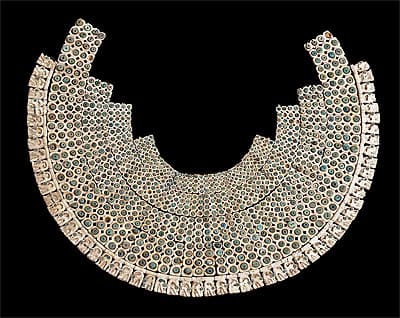
CUPISNIQUE culture North coast 1000 BC – 200 BC
Pectoral 1000–200 BC conch shell and chrysocolla34.8 (h) x 46.0 (w) cm Museo Larco, Lima Photograph: Daniel Giannoni
The pectoral’s exquisite, painstaking workmanship and exotic materials mean it was definitely created for a man of the Cupisnique elite. It consists of four rows of blue beads set inside carved shell plaques, each row being included in four courses of differing lengths. A border of jaguar heads with blue eyes is, like the plaques, carved from queen conch shell, imported from the warm waters of seas further to the north, perhaps even the Caribbean. The material was highly prized:
Shells and other products of the sea were highly symbolic materials in ancient Andean cultures and played a major role in myth and religion. They were often included in articles of adornment and symbols of rank.1
The 740 blue stones are made from chrysocolla,2 a copper silica ore also known as Peruvian turquoise. Both red and blue semi-precious shells and stones were valued and sought for their intense colours, and were often inlaid or made into beads.
Christine Dixon
1. Heidi King in Kathleen Berrin (ed.), The spirit of ancient Peru: Treasures from the Museo Arqueológico Rafael Larco Herrera, New York: Thames and Hudson 1997, cat. 142, p. 196.
2. Meinrad Maria Grewenig (ed.), IncaGold: 3000 years of advanced civilisation: asterpieces from Peru’s Larco Museum / Incaor 3000 ans de civilisations développées: Joyaux du Musée Larco Pérou, Heidelberg: Kehrer 2004, p. 28.
The pectoral’s exquisite, painstaking workmanship and exotic materials mean it was definitely created for a man of the Cupisnique elite. It consists of four rows of blue beads set inside carved shell plaques, each row being included in four courses of differing lengths. A border of jaguar heads with blue eyes is, like the plaques, carved from queen conch shell, imported from the warm waters of seas further to the north, perhaps even the Caribbean. The material was highly prized:
Shells and other products of the sea were highly symbolic materials in ancient Andean cultures and played a major role in myth and religion. They were often included in articles of adornment and symbols of rank.1
The 740 blue stones are made from chrysocolla,2 a copper silica ore also known as Peruvian turquoise. Both red and blue semi-precious shells and stones were valued and sought for their intense colours, and were often inlaid or made into beads.
Christine Dixon
1. Heidi King in Kathleen Berrin (ed.), The spirit of ancient Peru: Treasures from the Museo Arqueológico Rafael Larco Herrera, New York: Thames and Hudson 1997, cat. 142, p. 196.
2. Meinrad Maria Grewenig (ed.), IncaGold: 3000 years of advanced civilisation: asterpieces from Peru’s Larco Museum / Incaor 3000 ans de civilisations développées: Joyaux du Musée Larco Pérou, Heidelberg: Kehrer 2004, p. 28.
The pectoral’s exquisite, painstaking workmanship and exotic materials mean it was definitely created for a man of the Cupisnique elite. It consists of four rows of blue beads set inside carved shell plaques, each row being included in four courses of differing lengths. A border of jaguar heads with blue eyes is, like the plaques, carved from queen conch shell, imported from the warm waters of seas further to the north, perhaps even the Caribbean. The material was highly prized:
Shells and other products of the sea were highly symbolic materials in ancient Andean cultures and played a major role in myth and religion. They were often included in articles of adornment and symbols of rank.1
The 740 blue stones are made from chrysocolla,2 a copper silica ore also known as Peruvian turquoise. Both red and blue semi-precious shells and stones were valued and sought for their intense colours, and were often inlaid or made into beads.
Christine Dixon
1. Heidi King in Kathleen Berrin (ed.), The spirit of ancient Peru: Treasures from the Museo Arqueológico Rafael Larco Herrera, New York: Thames and Hudson 1997, cat. 142, p. 196.
2. Meinrad Maria Grewenig (ed.), IncaGold: 3000 years of advanced civilisation: asterpieces from Peru’s Larco Museum / Incaor 3000 ans de civilisations développées: Joyaux du Musée Larco Pérou, Heidelberg: Kehrer 2004, p. 28.

